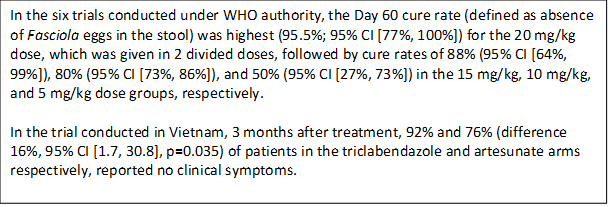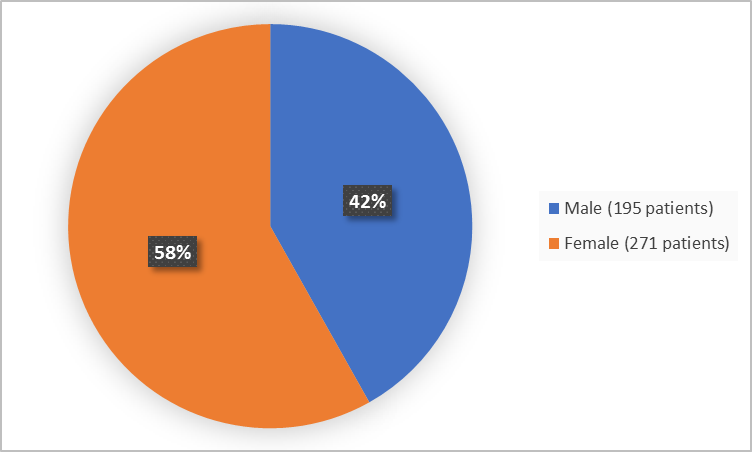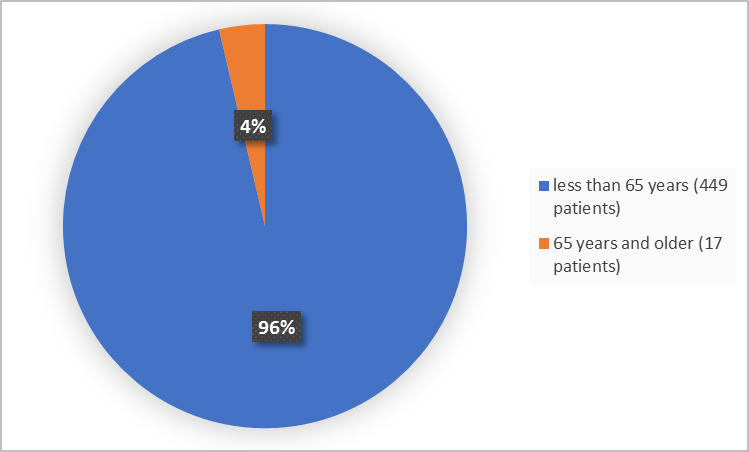Drug Trials Snapshots: EGATEN
HOW TO USE THIS SNAPSHOT
The information provided in Snapshots highlights who participated in the clinical trials that supported the FDA approval of this drug, and whether there were differences among sex, race, and age groups. The “MORE INFO” bar shows more detailed, technical content for each section. The Snapshot is intended as one tool for consumers to use when discussing the risks and benefits of the drugs.
LIMITATIONS OF THIS SNAPSHOT:
Do not rely on Snapshots to make decisions regarding medical care. Always speak to your health provider about the risks and benefits of a drug. Refer to EGATEN Prescribing Information for complete information.
EGATEN (triclabendazole)
egg-ah-ten
Novartis Pharmaceuticals Corporation
Approval date: February 13, 2019
DRUG TRIALS SNAPSHOT SUMMARY:
What is the drug for?
EGATEN is used to treat fascioliasis in patients 6 years of age and older.
Fascioliasis is an infectious disease caused by the parasitic flatworms Fasciola hepatica and gigantica, also known as liver flukes. The initial infection is characterized by fever, abdominal pain, and increase elevation in liver enzymes. Over months to years, the disease may become chronic with occasional pain in the abdomen, jaundice, anemia, and blockage of bile ducts where adult flukes live. During this phase, parasite eggs are present in the stool.
How is this drug used?
EGATEN is a tablet taken by mouth in two divided doses 12 hours apart. The total dose is determined by the patient’s weight.
What are the benefits of this drug?
In clinical trials, more than 90% of patients treated with EGATEN were cured of their clinical symptoms or no longer had parasite eggs in their stool.
What are the benefits of this drug (results of trials used to assess efficacy)?
EGATEN Prescribing Information
Were there any differences in how well the drug worked in clinical trials among sex, race and age?
- Sex: EGATEN works similarly in males and females.
- Race: Data not collected.
- Age: EGATEN works similarly among tested age groups.
Were there any differences in how well the drug worked in clinical trials among sex, race, and age groups?
Presented below are efficacy results by sex in 6 pooled trials conducted under WHO authority and one trial conducted in Vietnam, respectively.
Table 1. Pooled Cure Rate (Day 60) from WHO Trials by Sex
| EGATEN Regimen | All | Males | Females |
|---|---|---|---|
| 10 mg/kg (single dose or 2 x 5 mg/kg on day 1) | 121/151 (80.1) | 59/67 (88.1) | 62/84 (73.8) |
| 20 mg/kg (10 mg/kg on days 1 and 3) | 21/22 (95.5) | 10/11 (90.9) | 11/11 (100) |
Table 2. Efficacy by Sex (Month 3) from the Trial Conducted in Vietnam
| EGATEN 10 mg/kg BID x 1d |
Artesunate 4 mg/kg QD x 10d |
Diff (T-A) 95% CI | |
|---|---|---|---|
| No Clinical Symptoms* | |||
| Male | 20/22 (90.9) | 12/16 (75) | 15.9 (-9.3, 39.8) |
| Female | 26/28 (92.9) | 26/34 (76.5) | 16.4 (-2.7, 32.7) |
*The no clinical symptoms endpoint is based on no reported abdominal pain, fever, itchiness, urticarial rash or jaundice among persons with a follow-up report at month 3.
Adapted from FDA Review
Presented below are efficacy results by age group from pooled WHO trials.
Table 3. Pooled Cure Rates (Day 60) from WHO Trials by Age Group
| Age at Enrollment | |||
|---|---|---|---|
| EGATEN Regimen | 6-11 years | 12-16 years | >17 years |
| 10 mg/kg (single dose or 2 x 5 mg/kg on day 1) | 31/34 (91) | 23/28 (82) | 67/89 (75) |
| 20 mg/kg (10 mg/kg on days 1 and 3) | 4/4 (100) | 5/5 (100) | 12/13 (92) |
Adapted from FDA Review
What are the possible side effects?
EGATEN may cause heart rhythm problems (QT prolongation) especially in those who have underlying heart rhythm problems or who take drugs that alter heart rhythm. The most common side effects of EGATEN are pain in the abdomen, sweating, nausea, decreased appetite and headache.
What are the possible side effects (results of trials used to assess safety)?
Adverse reactions that occurred in patients in 6 clinical trials conducted under WHO authority for treatment of fascioliasis are presented below.
Table 4. Adverse Reactions Occurring in >2% of Patients Who Received a Total of 10 mg/kg or 20 mg/kg Triclabendazole (Pooled across 6 trials)
| Adverse Reactions | 10 mg/kg N=186, n (%) |
20 mg/kg in two divided doses1 N=28, n (%) |
|---|---|---|
| Abdominal pain2 | 105 (56) | 26 (93) |
| Hyperhidrosis | 42 (23) | 7 (25) |
| Vertigo | 16 (9) | 0 |
| Nausea | 15 (8) | 5 (18) |
| Urticaria | 12 (7) | 3 (11) |
| Vomiting | 11 (6) | 2 (7) |
| Headache | 11 (6) | 4 (14) |
| Dyspnea | 9 (5) | 0 |
| Pruritus | 8 (4) | 1 (4) |
| Asthenia | 7 (4) | 0 |
| Musculoskeletal chest pain | 7 (4) | 1 (4) |
| Cough | 7 (4) | 0 |
| Decreased appetite | 6 (3) | 5 (18) |
| Chest pain | 6 (3) | 0 |
| Pyrexia | 4 (2) | 0 |
| Jaundice3 | 4 (2) | 0 |
| Chest discomfort | 4 (2) | 0 |
| Diarrhea | 0 | 2 (7) |
1Divided doses were given 6-48 hours apart
2Abdominal pain upper and abdominal pain
3Jaundice and ocular icterus
EGATEN Prescribing Information
Were there any differences in side effects among sex, race and age?
- Sex: The occurrence of side effects was similar in males and females.
- Race: Data not collected.
- Age: The majority of patients were less than 65 years of age; therefore, differences in side effects between younger and older age group (geriatric) could not be determined.
Were there any differences in side effects of the clinical trials among sex, race, and age groups?
The table below summarizes adverse events by sex which occurred during the clinical trials conducted under WHO authority
Table 5. Adverse Events by Sex from Pooled WHO Trials
| System Organ Class | EGATEN Dose | |||
|---|---|---|---|---|
| 10 mg/kg | 20 mg/kg | |||
| Female N=109 | Male N=77 | Female N=15 | Male N=13 | |
| Cardiac disorders | 2 (1.8) | 0 | 0 | 0 |
| Ear and labyrinth disorders | 16 (14.7) | 0 | 0 | 0 |
| Eye disorders | 1 (0.9) | 0 | 0 | 0 |
| Gastrointestinal disorders | 69 (63.3) | 36 (46.8) | 13 (86.7) | 13 (100) |
| General disorders and administration site conditions | 14 (12.8) | 4 (5.2) | 0 | 2 (15.4) |
| Hepatobiliary disorders | 3 (2.8) | 3 (3.9) | ||
| Infections and Infestations | 0 | 0 | 2 (13.3) | 1 (7.7) |
| Metabolism and nutrition disorders | 2 (1.8) | 2 (2.6) | 3 (20) | 2 (15.4) |
| Musculoskeletal and connective tissue disorders | 10 (9.2) | 3 (3.9) | 2 (13.3) | 0 |
| Nervous system disorders | 10 (9.2) | 0 | 4 (26.7) | 0 |
| Psychiatric disorders | 0 | 0 | 1 (6.7) | 0 |
| Renal and urinary disorders | 1 (0.9) | 2 (2.6) | 1 (6.7) | 0 |
| Respiratory, thoracic and mediastinal disorders | 12 (11) | 4 (5.2) | 0 | 0 |
| Skin and subcutaneous tissue disorders | 34 (31.2) | 25 (32.5) | 6 (40) | 4 (30.8) |
| Vascular disorders | 2 (1.8) | 0 | 0 | 0 |
Adapted from FDA review
WHO WAS IN THE CLINICAL TRIALS?
Who participated in the clinical trials?
The FDA approved EGATEN based primarily on evidence from 9 clinical trials of 466 patients with fascioliasis. Because these were old trials and not conducted under FDA authority, some demographic data were incomplete.
Six trials were conducted between 1989 and 1992 in Iran, Bolivia, Peru, Cuba, and Chile under the World Health Organization authority.
The FDA also considered data from 3 published trials conducted under local authorities: the first one was conducted from 2004-2005 in Vietnam, second from 2007-2010 in Egypt and the third one from 2001-2006 in Peru.
Figure 1 summarizes by sex how patients were in the combined nine clinical trials.
Figure 1. Baseline Demographics by Sex
Clinical trial data
Baseline Demographics by Race
Data not collected.
Figure 2 summarizes how many patients of a certain age were in the combined nine clinical trials.
Figure 2. Baseline Demographics by Age
Clinical trial data
Who participated in the trials?
The table below summarizes demographics of all patients in the nine clinical trials that supported safety and efficacy of EGATEN. Race and ethnicity data were not collected.
Table 6. Baseline Demographics of Patients in Combined Clinical
| Demographic Parameters | Total (N=466) n (%) |
|---|---|
| Sex | |
| Male | 195 (42) |
| Female | 271 ( 58) |
| Age (years) | |
| Min., Max. | 5, 75 |
| Age Group | |
| <65 years | 449 |
| ≥65years | 17 |
| Geographic Region | |
| USA | 0 |
| Rest of the World | 466 (100%) |
Clinical trial data
How were the trials designed?
There were nine trials that provided data for assessment of benefit and side effects of EGATEN.
The six trials done under WHO authority enrolled patients with fascioliasis as documented by the presence of parasite eggs in the stool. Patients received various doses of EGATEN. The treatment lasted one to three days. Both patients and investigators knew which treatment was given. The benefit of EGATEN was evaluated after 60 days by counting the number of patients who no longer had parasite eggs in their stool.
The trial conducted in Vietnam enrolled patients who had symptoms of fascioliasis. Half of the patients received EGATEN and half received a drug called artesunate which is used to treat another parasitic disease. EGATEN was given twice for one day and artesunate once a day for 10 days. Both patients and the investigators knew which treatment was given. The benefit of EGATEN was evaluated 90 days after the treatment by counting the number of patients who did not have symptoms.
The two additional trials provided supportive evidence for EGATEN.
How were the trials designed?
The assessment of safety and efficacy of EGATEN were based primarily on data from nine clinical trials in patients with fascioliasis.
In 6 non-randomized, open label trials, 245 adult and pediatric patients with stool-confirmed fascioliasis were treated with EGATEN (or its generic version) from 5 mg/kg to 20 mg/kg administered on days 1-3. Cure was defined as absence of Fasciola eggs in the stool based on the Kato-Katz method at Day 60 in patients who were positive at baseline. These trials provide for safety assesment as well. In an open label, randomized trial, conducted in Vietnam, 100 patients with acute symptomatic fascioliasis were randomized to triclabendazole (two 10 mg/kg doses 12 hours apart given with food) or oral artesunate (4 mg/kg, given once daily for 10 days). Cure was defined as absence of clinical symptoms. In this trial, no safety data were collected.
Additional supportive efficacy and safety assessments were obtained from:
- one open label trial conducted in Egypt in patients with stool-confirmed fascioliasis who were treated with two different artemether doses; clinical failures were treated with EGATEN. Cure was defined as absence of Fasciola eggs 28 days after final dose.
- one open label trial in Peru of 84 pediatric patients treated with EGATEN either 7.5 mg/kg bid for 2 doses or 10mg/kg in single dose. Cure was defined as absence of Fasciola eggs in the stool at Day 60.
GLOSSARY
CLINICAL TRIAL: Voluntary research studies conducted in people and designed to answer specific questions about the safety or effectiveness of drugs, vaccines, other therapies, or new ways of using existing treatments.
COMPARATOR: A previously available treatment or placebo used in clinical trials that is compared to the actual drug being tested.
EFFICACY: How well the drug achieves the desired response when it is taken as described in a controlled clinical setting, such as during a clinical trial.
PLACEBO: An inactive substance or “sugar pill” that looks the same as, and is given the same way as, an active drug or treatment being tested. The effects of the active drug or treatment are compared to the effects of the placebo.
SUBGROUP: A subset of the population studied in a clinical trial. Demographic subsets include sex, race, and age groups.



